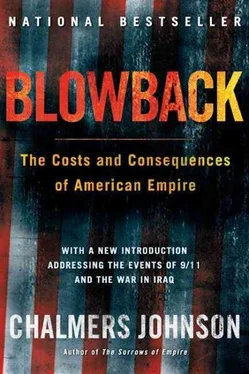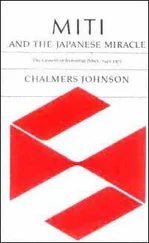Chalmers Johnson - Blowback, Second Edition - The Costs and Consequences of American Empire
Здесь есть возможность читать онлайн «Chalmers Johnson - Blowback, Second Edition - The Costs and Consequences of American Empire» весь текст электронной книги совершенно бесплатно (целиком полную версию без сокращений). В некоторых случаях можно слушать аудио, скачать через торрент в формате fb2 и присутствует краткое содержание. Год выпуска: 0101, ISBN: 0101, Издательство: Macmillan, Жанр: Старинная литература, на английском языке. Описание произведения, (предисловие) а так же отзывы посетителей доступны на портале библиотеки ЛибКат.
- Название:Blowback, Second Edition: The Costs and Consequences of American Empire
- Автор:
- Издательство:Macmillan
- Жанр:
- Год:0101
- ISBN:9780805075595
- Рейтинг книги:5 / 5. Голосов: 1
-
Избранное:Добавить в избранное
- Отзывы:
-
Ваша оценка:
- 100
- 1
- 2
- 3
- 4
- 5
Blowback, Second Edition: The Costs and Consequences of American Empire: краткое содержание, описание и аннотация
Предлагаем к чтению аннотацию, описание, краткое содержание или предисловие (зависит от того, что написал сам автор книги «Blowback, Second Edition: The Costs and Consequences of American Empire»). Если вы не нашли необходимую информацию о книге — напишите в комментариях, мы постараемся отыскать её.
Blowback, Second Edition: The Costs and Consequences of American Empire — читать онлайн бесплатно полную книгу (весь текст) целиком
Ниже представлен текст книги, разбитый по страницам. Система сохранения места последней прочитанной страницы, позволяет с удобством читать онлайн бесплатно книгу «Blowback, Second Edition: The Costs and Consequences of American Empire», без необходимости каждый раз заново искать на чём Вы остановились. Поставьте закладку, и сможете в любой момент перейти на страницу, на которой закончили чтение.
Интервал:
Закладка:
Judith Stein, a professor of history at the City College of New York, has detailed how the de facto U.S. industrial policy of sacrificing American workers to pay for its empire devastated African-American households in Birmingham, Alabama, and Pittsburgh, Pennsylvania. This is, of course, but another form of blowback. She writes, “At the outset of the Cold War, reconstructing or creating steel industries abroad was a keystone of U.S. strategic policy, and encouraging steel imports became a tool for maintaining vital alliances. The nation’s leaders by and large ignored the resulting conflict between Cold War and domestic goals. Reminiscing about elite thinking in that era, former Federal Reserve Board chairman Paul A. Volcker recalled that ‘the strength and prosperity of the American economy was too evident to engender concern about the costs.’ ” 2Moreover, American economic ideologues always dominated what debate there was, couching the problem in terms of protectionism versus internationalism, never in terms of prosperity for whites versus poverty for blacks. The true costs to the United States should be measured in terms of crime statistics, ruined inner cities, and drug addiction, as well as trade deficits.
U.S. officials did finally start to negotiate more or less seriously with the Japanese and the other “miracle economies” to open their markets to American goods. But the attempt always collided with the security relationship. In order to level the economic playing field, the United States would have had to level the security playing field as well, and this it remains unwilling to do.
In East Asia, to create industries that could export to the American market, design the right products, and achieve competitive prices and levels of quality, governmental industrial policies became the norm. Japan was the regional pioneer in creating model collaborative relationships between government and industry. In part, it drew on its history as one of the world’s most successful late industrializers and on its wartime production system, in which the government and the huge zaibatsu , or corporate combines, had worked together to produce the weapons that Japan needed. After the onset of the Cold War, the Americans did very little to prevent the Japanese from re-creating the combines (now called keiretsu ) and the legal structure that supported them, largely because occupation officials either failed to recognize what was happening or were blind to its implications.
To base a capitalist economy mainly on export sales rather than domestic demand, however, ultimately subverts the function of the unfettered world market to reconcile and bring into balance supply and demand. Instead of producing what the people of a particular economy can actually use, East Asian export regimes thrived on foreign demand artificially engineered by an imperialist power. In East Asia during the Cold War, the strategy worked so long as the American economy remained overwhelmingly larger than the economies of its dependencies and so long as only Japan and perhaps one or two smaller countries pursued this strategy. But by the 1980s the Japanese economy had become twice the size of both Germanies. Anything it did affected not just the American but the global economy. Moreover, virtually everyone else in East Asia (and potentially every underdeveloped country on earth) had some knowledge of how to create such a miracle economy and many were trying to duplicate Japanese-style high-speed growth. An overcapacity for products oriented to the American market (or products needed to further expand export-oriented economies) became overwhelming. There were too many factories turning out athletic shoes, automobiles, television sets, semiconductors, petrochemicals, steel, and ships for too few buyers. The current global demand for automobiles, for example, seems to have peaked at around 50 million vehicles at a moment when capacity has already grown to 70 million. To make matters worse, as a result of the global economic crisis, auto sales in Southeast Asia fell from 1.3 million in 1997 to 450,000 in 1998.
This is not to say that all the barefoot peoples of the world who might like to wear athletic shoes or all the relatively poor people who might someday be able to afford a television set or an automobile are satisfied. But for now they are too poor to be customers. The current overcapacity in East Asia has created intense competition among American and European multinational corporations. Their answer has been to lower costs by moving as much of their manufacturing as possible to places where skilled workers are paid very little. These poorly paid workers in places like Vietnam, Indonesia, and China cannot consume what they produce, while middle- and lower-class consumers back in the United States and Europe cannot buy much more either because their markets are saturated or their incomes are stagnant or falling. The underlying danger is a structural collapse of demand leading to recession and ultimately to something like the Great Depression. As the economic journalist William Greider has put it in his book One World, Ready or Not , “Shipping high-wage jobs to low-wage economies has obvious, immediate economic benefits. But, roughly speaking, it also replaces high-wage consumers with low-wage ones. That exchange is debilitating for the entire system.” 3The only answer is to create new demand by paying poor people more for their work. But the political authorities capable of enacting and enforcing rules to enlarge demand could not do so even if they wanted to because “globalization” has placed the matter beyond their control.
A crisis of oversupply was inevitable given the passage of time and the unwillingness of imperial America to reform its system of satellites. Even in the late 1990s, the American economy continued to serve as the consumer of last resort for the enormous manufacturing capacity of all of East Asia, although doing so produced trade deficits that cumulatively transferred trillions of dollars from the United States to Asia. This caused an actual decline in the household incomes of the bottom tenth of American families, whose real incomes fell by 13 percent between 1973 and 1995. It was only in 1997 that a weak link snapped—not, ironically, in trade, but finance—and threatened to bring the system down.
The financial systems of all the high-growth East Asian economies were based on encouraging exceptionally high domestic household savings as the main source of capital for industrial growth. Such savings were achieved by discouraging consumption through the high domestic pricing of consumer goods (which, of course, also led to charges of “dumping” of normally priced goods when they were sent abroad). To save in such a context was a patriotic act, but it was also a matter of survival in societies that provided little in the way of a social safety net for times of emergencies, and in which housing often had to be bought outright or in which interest payments on mortgages was not treated favorably as a tax deduction.
East Asian governments collected these savings in banks affiliated with industrial combines or in government savings institutions such as post offices. In organizing their economies, they had chosen not to rely primarily on stock exchanges to raise the capital their export industries needed. Instead they found it much more effective to guide the investment of the savings in these banks to the industries the governments wanted to develop. In East Asia, ostensibly private banks thus became partners in business enterprises and industrial groups, not independent creditors concerned first and foremost with the profitability of a company or the success of a loan. These banks in effect followed government orders and felt secure so long as they did so.
Superficially, corporations in most East Asian countries looked like their American or European equivalents, but in this case appearances were indeed deceptive. As the American corporate raider T. Boone Pickens discovered when he tried to buy a small Japanese company that made auto headlights, a significant block of shares was held by the Toyota Motor Company. The firm he wanted to acquire was part of the automaker’s keiretsu , or conglomerate of cooperating firms and banks. Although Pickens acquired what in the United States would have been a controlling interest in the company, Toyota blocked his takeover and prevented him from naming his own directors and corporate officers. The fact that Pickens was able to buy the shares at all was a fluke in Japanese corporate governance, the result of a single disgruntled stockholder. Until very recently Japanese corporations were “owned” entirely by one another in elaborate cross-share-holding deals designed to keep people like Pickens out and to keep the enterprise working for the country rather than for the profits of shareholders. The sale of shares was not a way to raise capital, and the people who held them were uninterested in the risks or profits that the company’s operations entailed.
Читать дальшеИнтервал:
Закладка:
Похожие книги на «Blowback, Second Edition: The Costs and Consequences of American Empire»
Представляем Вашему вниманию похожие книги на «Blowback, Second Edition: The Costs and Consequences of American Empire» списком для выбора. Мы отобрали схожую по названию и смыслу литературу в надежде предоставить читателям больше вариантов отыскать новые, интересные, ещё непрочитанные произведения.
Обсуждение, отзывы о книге «Blowback, Second Edition: The Costs and Consequences of American Empire» и просто собственные мнения читателей. Оставьте ваши комментарии, напишите, что Вы думаете о произведении, его смысле или главных героях. Укажите что конкретно понравилось, а что нет, и почему Вы так считаете.










